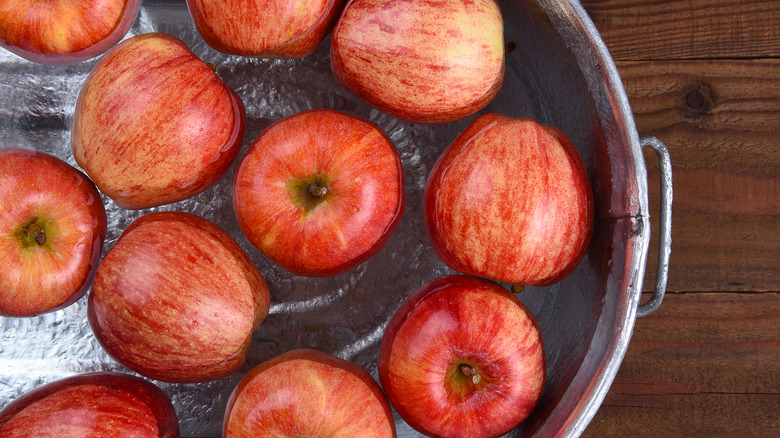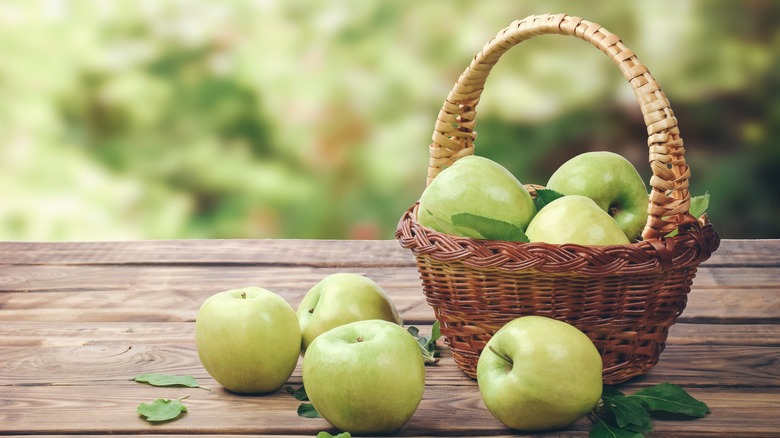The Unexpected Origin Of Bobbing For Apples
The apple, in many, is a humble, handy, and inoffensive fruit. It tends to be neither too sweet nor too tart. It's conveniently portable with little to no mess, thanks to its skin. It's about the right size for a single-portion snack. It may not have the strongest taste, but there are just enough varieties to ensure that everyone has their favorite.
The nutritional benefits of apples are numerous too. According to Healthline, potassium, fiber, and vitamin C are abundant in them, and they're low in calories too. This is not the case, however, when they're used in desserts, such as apple pies and candy apples.
With all these fine characteristics in mind, it's no surprise that apples are so popular. In 2016, China became the nation that exports the most of this succulent fruit — no less than 1.32 million tons of them, according to the China Chamber of Commerce of Foodstuffs and Native Produce (via Produce Report). The notion of bobbing for apples is almost as popular as the fruit itself, and it seems to derive from an old custom that tried to determine how successful a potential couple's relationship might be.
The time-honored tradition of apple bobbing
Now, there are various traditional ways of gauging the prospects of a potential relationship. The classic flower petal "they love me, they love me not" is just one example. The science of such things is shaky enough to roll right off the table and under the couch, but methods like these indicate that a certain level of superstition has long been connected to such things.
Today, millions around the world know apple bobbing as a bit of holiday fun, a Halloween distraction that also serves as a way for wily adults to encourage children to eat more fruit. It's also taken super seriously by other groups, however. In an October 2015 live event in Japan, Cherry Yoshitake successfully bobbed a total of 37 apples in one minute. This, per Guinness World Records, remains a world record.
Let's put the potentially incredible world of competitive apple bobbing aside, though. The simple act of bobbing one's head into a container of water and apples, then trying to extract the nutritious fruit using only the teeth, is a familiar one. According to History, though, the practice has its unexpected origins in Britain (a well-known home of the apple). There, young women in centuries past would gauge whether a potential partner was right for them by how successful they were at bobbing for the apple they had assigned to that person.
Apples: more romantic than you thought
It's crucial to put a lot of thought into any romantic relationship. What are the other person's hopes and dreams? Do your attitudes on financial matters line up? Things like these will prove to be important factors in the decision, particularly in the case of a long-term relationship. A little apple bobbing science is also important, apparently.
Per History, it was said in England that one would see an image of their beloved in their dreams if they put a bitten apple under their pillow. The tradition of bobbing took this connection a step further, though. Players would assign an apple in the container to a person with whom they wanted to pursue a relationship. They would then bob away, and their success would determine the potential success of the relationship. If it took more than three attempts, there would be no chance. Success on the first try, however, meant the relationship would be a sure thing.
This superstition, the outlet goes on, was largely forgotten and only attributed to the Irish by the beginning of the 19th century, but it may date back much further. History states that the Romans, on conquering the Celts, strived to incorporate their own festivals and traditions with those of their new subjects. Pomona, for the Romans, was goddess of fruit, trees, and apples, and perhaps both cultures' traditions of honoring their deities and their dead collided in Halloween apple bobbing.


